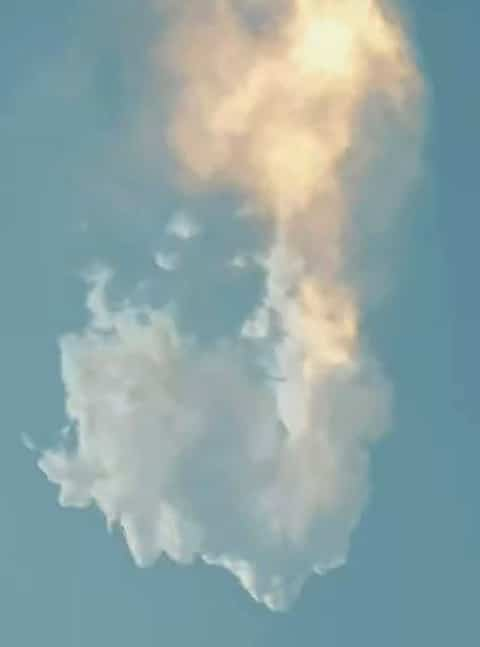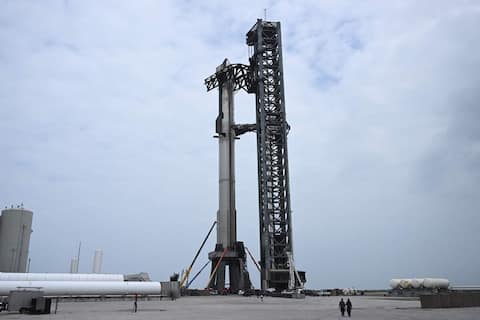![[À VOIR] SpaceX’s Starship rocket explodes in mid-air [À VOIR] SpaceX’s Starship rocket explodes in mid-air](https://m1.quebecormedia.com/emp/emp/65428270-df87-11ed-891f-ab7ac66c3d41_ORIGINAL.jpg?impolicy=crop-resize&x=0&y=156&w=1200&h=494&width=1200)
Starship, the world’s largest rocket built by SpaceX for missions to the Moon and Mars, exploded in mid-air shortly after liftoff, but this first test flight has already been a huge success for the company.
In a colossal fireball, the 120-meter-tall black and silver behemoth tore itself off the ground at 8:30 a.m. local time, much to the cheers of SpaceX employees.
The scene of this much-anticipated spectacle is SpaceX’s Starbase space station located in South Texas, USA.
The cause of the explosion is not yet known. The purpose of this test flight was to collect as much data as possible to improve the following prototypes.
On Monday, the first launch attempt was canceled in the final minutes of the countdown due to a technical glitch.
“This is the first flight of the biggest, most complex rocket,” SpaceX boss Elon Musk said Sunday, calling the test “very dangerous.”
At 120 meters tall, Starship is larger than NASA’s newest mega-rocket, the SLS (98 m), which launched for the first time in November, and the legendary Saturn V, the Apollo lunar program’s rocket (111 m).
The starship’s liftoff thrust is twice as powerful as those of these two launchers—the strongest in the world.
It had never flown before in its complete configuration, with its highly powerful first stage, known as the Super Heavy, and equipped with no less than 33 engines.
Only the vehicle’s second stage, the Starship spacecraft, extended its designation to the entire rocket and carried out sub-orbital tests (about 10 km altitude).
He was selected by NASA as the lander for a modified version of the Artemis 3 mission, which was supposed to return astronauts to the lunar surface for the first time in more than half a century. Officially in 2025.
On Thursday, the flight plan was as follows: About three minutes after takeoff, the superheavy would break up and fall back into the waters of the Gulf of Mexico. But this separation did not take place and the rocket continued to spin before exploding.
Had the separation been successful, the starship should have fired its six engines and continued its ascent to an altitude of over 150 km. After traveling a little less than one turn of the Earth for about an hour, it will fall back into the Pacific Ocean.
But going through all these steps on the first test flight would have been a real feat.
Elon Musk wanted to lower expectations, saying that achieving orbit on the first try was unlikely.
He was content to hope that the launch pad was not destroyed by the explosion of the super-heavy engines during ignition.
“My biggest wish is that please (…) we’re a long way from the launch pad before something goes wrong,” he said.
The rocket already has customers: Starship’s first crewed flight is to be produced with American billionaire Jared Isaacman.
Japanese billionaire Yusaku Maezawa and American Dennis Tito (the first space tourist in history) have said they want to travel around the moon.
Starship can carry 150 tonnes of cargo into orbit. By comparison, SpaceX’s Falcon 9 rocket can only carry a little more than 22 tons into low Earth orbit.
But the real innovation of the Starship is that it will be fully reusable — something Elon Musk hopes to achieve “within two or three years.”
For this first test, do not attempt to recover any of the two stages of the rocket. But eventually, the superheavy must come back to rest against its launch tower, equipped with two arms to propel it.
The starship must return to Earth using retrorockets. This maneuver was tried several times in 2020 and 2021. After several explosions during landing, a prototype finally landed successfully.
The idea of a reusable launcher is Elon Musk’s grand strategy to keep costs down. Each Starship flight will ultimately cost only “a few million” dollars, he says.
An imperative for the billionaire, he estimates that it would take hundreds of starship rockets for humans to become a multiplanetary species. Its ultimate goal is to establish an autonomous colony on Mars.







More Stories
More than 200 former Republican aides back Kamala Harris | US Election 2024
An investigation into the ill-treatment of the Lev Tahor sect in Guatemala
Brossard is suspected by the US of supporting Russia’s war effort